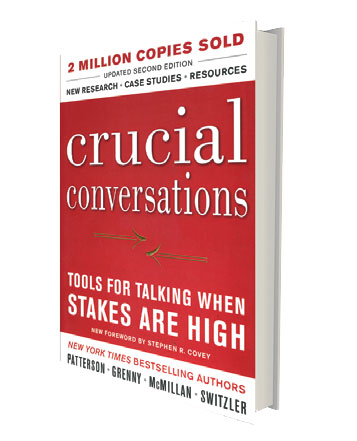A crucial conversation happens to us all through our life. It’s when:
– Sta kes are high
kes are high
– Emotions are strong
– Opposing opinions exist
There are tactics we can take to help build a dialog and get to a resolution.
“Everyone argues about important issues. But not everyone splits up. It’s how you argue that matters.”
When a conversation gets heated, we should know:
– What we want for ourselves
– What do we want for others
– What do we want for the relationship
We want to build a dialogue. And for this to happen, we need to make it safe for both sides. Dialog is the free flow of meaning between two people. And the sooner that we identify we’re out of dialog, the easier it is to move back into it.
And in between, we need to avoid the fool’s choice, which is the choice that’s best for the relationship OR keeping the relationship. We can have both.
e.g Ex. “How can I have a candid conversation with my husband about being more dependable and avoid creating bad feelings or wasting our time.”
The key is to create safety for both people. This allows people to openly talk about what they’d like without:
- Resorting to violence (controlling, attacking, labeling)
- Resorting to Silence (avoiding the issue, masking, withdrawing)
Safety is the key to a successful crucial conversation.
How to maintain it:
- Apologize if appropriate
- Create a Don’t / Do statement. “I don’t want to insinuate that the problem is just yours. I do want to talk to understand our finances better.”
- Create mutual purpose.
And we’re not perfect. So know if you are resorting into silence of violence. If this happens, take a breath and ask what do you want for yourself, for others, and the relationship. What do you not want. Then start to build safety again.
Remember that the situation doesn’t make you mad. Most of the time, YOU make YOU mad.
The story you tell yourself makes you mad.
- You see and hear things
- You create a story in your head of the intention and things that happened
- Emotions come from the story, not the situation
- And then you act. Emotions are the fuel to the act.
If we are being emotional, it’s good to take a breath and then review the story. What’s causing these emotions. And have we confirmed our story? Let’s start with the facts.
Facts are undeniable truths. But you have to separate the facts from your story.
S.hare your facts (start here)
T.ell your story. Explain what you’re about to conclude.
A.sk for other’s paths. Encourage them to share their facts and stories.
- Ask – ask their views.
- Mirror – Acknowledge the feeling. Empathize.
- Paraphrase – Repeat back for understanding. “So you mean…”
- Guess – If this isn’t working, make your best guess to what they’re feeling.
T.alk tentatively. Soften your approach and tell the story. It’s starting to look like… It’s leading me to conclude..
E.ncourage testing. Try a path to resolution and see if you can get buyoff. Make it safe to build opposing views.
Overall just remember you’re ABC’s:
Agree. Agree when you share views.
Build. If others leave something out, agree when you share views, then build.
Compare. When you differ significantly, compare your two views.
Finally ensure that your dialog moves to a decision. Or this was all for naught.
The key ponit:
Recognize when you or others are falling into silence or violence and then make it safe. Once you have safety, any conversation is possible.
